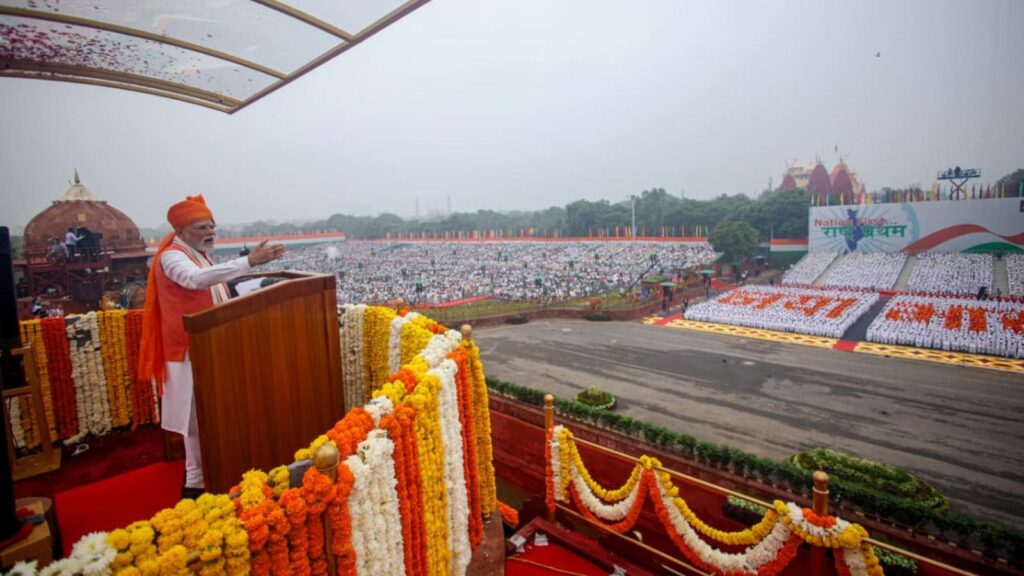970x125
Prime Minister Narendra Modi, in his Independence Day address from the Red Fort, called for India to become self-reliant in energy and critical minerals, pointing to the opportunity cost of a high petroleum import bill. Modi also said the government has “opened the doors” of nuclear energy to the private sector, and aims to grow nuclear generation capacity tenfold by 2047.
970x125
ARTICLE CONTINUES BELOW VIDEO
“We all know that we are dependent on many counties for energy, be it petrol, diesel, or gas. We have to spend lakhs of crores of rupees to import energy,” PM Modi said. “If we weren’t dependent, that money could have been used for India’s future, its farmers, and to fight poverty. But we are working on becoming self-reliant in this aspect,” he added.
In 2024-25, India’s crude oil imports were valued at $137 billion, petroleum products at $24 billion, and liquefied natural gas (LNG) at $15 billion. Altogether, they accounted for 22.3 per cent of India’s total imports, compared to 23 per cent in 2023-24, according to the Petroleum Planning and Analysis Cell of the Ministry of Petroleum and Natural Gas.
‘Critical minerals exploration ongoing at over 1,200 sites’
PM Modi said critical minerals have taken centre stage globally, underpinning technologies across sectors — from energy to industrial to defence. “That is why we have launched the National Critical Mineral Mission (NCMM). Exploration is underway at more than 1,200 sites, and we are moving ahead towards becoming self-reliant in critical minerals as well,” he said.
So far, the Ministry of Mines has auctioned 24 critical mineral blocks — some requiring further exploration and others ready for development into mines — and aims to auction 100 more by 2030. Mining sector experts caution, however, that operationalising auctioned mines could take several years. To address bottlenecks, the ministry has set up a Project Monitoring Unit (PMU) to streamline regulatory processes and expedite clearances.
In the meantime, the Centre is also doubling down on the exploration and acquisition of critical mineral blocks abroad. Earlier this week, the Lok Sabha passed amendments to the Mines and Minerals (Development & Regulation) Act, enabling the National Mineral Exploration Trust (NMET) to fund overseas exploration.
PM Modi eyes tenfold nuclear boost, greater private sector involvement
“India is taking big initiatives on nuclear energy. Ten new nuclear reactors are currently operational. We have also resolved to increase our nuclear energy capacity by 10 times by 2047,” PM Modi said in his address. India’s installed nuclear capacity stood at roughly 8.8 gigawatts (GW) as of June 30, accounting for just under 2 per cent of its total electricity generation capacity.
Story continues below this ad
“Reform is a continuous process… We have brought many reforms in the nuclear sector. We have now opened the doors of nuclear energy to the private sector as well. We want to combine our strengths,” Modi also said.
In the 2024-25 Budget, the government proposed partnering with the private sector to finance and build Bharat Small Reactors (BSRs) for captive use, to be commissioned and operated by the Nuclear Power Corporation of India (NPCIL).
Full-scale private participation, however, will require amendments to the Atomic Energy Act and the Civil Liability for Nuclear Damage Act, currently under internal discussion. A Department of Atomic Energy task force is also examining safeguards, fuel procurement, waste management, and other aspects of private ownership and operation of nuclear plants.
In his speech, PM Modi also noted that India has met a key climate target five years early, with non-fossil fuel sources accounting for 50 per cent of the country’s installed electricity capacity as of June 30. These sources — which include nuclear, large hydro, and renewables — made up just 30 per cent of installed capacity in 2015 and 38 per cent in 2020, before rising sharply over the last five years, on the back of solar and wind power.
© The Indian Express Pvt Ltd
970x125


